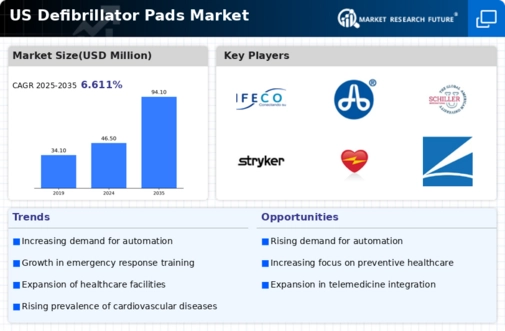Growing Incidence of Cardiac Arrests
The rising incidence of cardiac arrests in the US is a pivotal driver for the defibrillators pads market. Statistics indicate that nearly 350,000 out-of-hospital cardiac arrests occur annually, with survival rates significantly improving when defibrillation is administered promptly. This alarming trend underscores the necessity for accessible defibrillation solutions, thereby propelling demand for defibrillator pads. As healthcare providers and emergency responders increasingly recognize the critical role of these pads in emergency situations, the market is likely to experience substantial growth. Furthermore, the emphasis on rapid response in emergency medical services is expected to enhance the adoption of defibrillators and their associated pads, ultimately contributing to improved patient outcomes and a more robust market landscape.
Rising Public Access to Defibrillators
The increasing availability of public access defibrillators (PADs) is a crucial factor driving the defibrillators pads market. Initiatives aimed at placing defibrillators in public spaces, such as schools, airports, and shopping centers, are becoming more prevalent. This trend is supported by legislation in various states that mandates the installation of PADs in certain public venues. As more defibrillators are deployed, the corresponding need for replacement pads is expected to rise. Furthermore, public awareness campaigns emphasizing the importance of immediate defibrillation in cardiac emergencies are likely to encourage the use of these devices, thereby stimulating market growth for defibrillator pads.
Focus on Training and Certification Programs
The emphasis on training and certification programs for CPR and defibrillation is a notable driver for the defibrillators pads market. Organizations and institutions are increasingly recognizing the importance of equipping individuals with the skills necessary to respond effectively in cardiac emergencies. Training programs often include the use of defibrillators and their pads, thereby fostering familiarity and confidence among potential users. As more people become trained in these life-saving techniques, the demand for defibrillator pads is likely to increase. Additionally, partnerships between healthcare organizations and educational institutions to promote such training initiatives are expected to further enhance the market landscape, ensuring that more individuals are prepared to act in emergencies.
Technological Innovations in Defibrillator Pads
Technological advancements in the design and functionality of defibrillator pads are significantly influencing the defibrillators pads market. Innovations such as improved adhesive materials, enhanced conductivity, and user-friendly designs are making these pads more effective and easier to use. For instance, the introduction of pads that provide real-time feedback to users during defibrillation attempts is enhancing the efficacy of resuscitation efforts. Additionally, the integration of smart technology, such as connectivity with mobile devices for monitoring and data collection, is likely to attract more users. As these innovations continue to evolve, they are expected to drive market growth by increasing the appeal and effectiveness of defibrillator pads in emergency situations.
Increased Investment in Emergency Medical Services
The growing investment in emergency medical services (EMS) across the US is a significant driver for the defibrillators pads market. With federal and state funding initiatives aimed at enhancing emergency response capabilities, many EMS organizations are upgrading their equipment, including defibrillators and pads. Reports suggest that funding for EMS has increased by approximately 15% over the past few years, reflecting a commitment to improving public health outcomes. This financial support enables EMS providers to acquire the latest technology in defibrillation, thereby increasing the demand for high-quality pads. As a result, the defibrillators pads market is poised for growth, driven by the need for advanced equipment in emergency medical settings.



















Leave a Comment